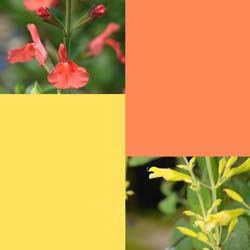Pantone Pageant Cheerful Lemon Zest and Nectarine Designer Salvias

Let there be light; let there be brightness. Yellows and oranges are cheerful colors to combine in a grouping of perennials. Pantone's spring 2013 designer colors -- golden yellow Lemon Zest 13-0756 and its hot orange Nectarine 16-1360 -- are fun colors to match to sages (Salvia spp.) that can turn up the light in a garden whether sunny or shady.
After touring our catalog for Lemon Zest and Nectarine matches, we've collected some sages (Salvia spp.) for cheerful gardens offering full sun to partial shade. The two groupings are based on mutual cultivation needs and attractive combinations of height and volume. Each group includes an interloper that isn't part of Pantone's spring colors.
Let's dig in; here are our planting suggestions.
Perennial Bed for Full Sun to Partial Shade
All of these Salvias are native to Mexico. However, the Autumn Sages are also native to the American Southwest. Although all are agreeable to full sun with some partial shade, it's a good idea to lean toward lots of direct sunshine because Autumn Sage needs it.
As with humans, life in the garden is about compromise. Accommodating water to the needs of all is necessary to succeed in grouping these plants together. The Red Stem Forsythia Sage loves water whereas the Oaxaca Orange Wooly Sage prefers soil on the dry side. Providing regular, but not excessive watering, is an acceptable middle ground for all. The definition of regular depends on local rainfall. Gardeners in semi-arid or drought-stricken regions need to water more frequently than those in areas with moderate weekly rainfall.
Soil fertility is another matter for compromise. Red Stem Forsythia and Oaxaca Orange are in agreement about preferring rich soils. Although the other three sages tend to like soils on the lean side, they can deal with loamy garden soils. But hold back on the fertilizer to gain a good show of flowers from all.
And yes, Salvia dysjuncta is the Pantone outsider.
Oaxaca Orange Wooly Sage (Salvia lineata) Zones 7 to 11.
- Nectarine-orange flowers
- Blooms summer into fall
- 24 to 36 inches tall, 36 inches wide
- Hairy, heart-shaped, forest-green leaves
- Full sun to partial shade
Lowrey's Peach Autumn Sage (Salvia greggii 'Lowrey's Peach') Zones 7 to 9.
- Nectarine-orange flowers
- Blooms spring to fall
- 36 inches tall and wide
- Glossy green foliage
- Full sun to partial shade
California Sunset Autumn Sage (Salvia x jamensis 'California Sunset') Zones 7 to 9.
- Nectarine-orange flowers
- Blooms spring to fall; lightest bloom in summer
- 36 inches tall and wide
- Small, smooth foliage
- Full sun to partial shade
Southern Mexican Sage (Salvia disjuncta) Zones 7 to 11.
- Red-orange flowers (not a Pantone choice)
- Blooms late autumn to spring
- 40 to 48 inches tall, 40 inches wide
- Rumply, dark green, lance-shaped leaves
- Full sun to partial shade
Red Stem Forsythia Sage (Salvia madrensis 'Red Neck Girl') Zones 7 to 11.
- Lemon-yellow flowers
- Blooms fall to spring; dies back at first frost
- 60 to 72 inches tall, 48 inches wide
- Thick, red, square stems and heart-shaped leaves
- Full sun to partial shade
Two other varieties of Salvia madrensis, which include Silver Leaf and grow up to 10 feet tall, are dramatic as stand-alone plants or screens in the late summer-to-fall garden.
Shady Woodland Border
Given regular watering and partial shade, these three sages -- two from Asia and one from Mexico -- will form international accord along a garden path or foundation border. The interloper here is the hot pink Chiapas Sage from Mexico's coastal mountains.
As with most sages, these plants need well-drained soil. While the Asian species love rich soil, they can probably get by on less fertilizer to accommodate Chiapas Sage's habit of growing in average soil. Adding compost to the soil for aeration and some enrichment is a good compromise.
Campanulata Leaf Sage (Salvia campanulata) Zones 5 to 9.
- Lemon-yellow flowers
- Blooms summer to fall
- 24 to 48 inches tall, 36 inches wide
- Basal, almost round leaves
- Partial to Full Shade
Formosan Woodland Sage or Tai wan qin zhu cao (Salvia nipponica var. Formosana) Zones 7 to 9.
- Lemon-yellow flowers
- Blooms summer to fall
- 12 to 24 inches tall, 24 inches wide
- Green and purple arrow-shaped leaves
- Partial to Full Shade
Chiapas Sage (Salvia chiapensis) Zones 7 to 11.
- Hot pink flowers
- Blooms spring to fall
- 36 to 48 inches tall, 36 inches wide
- Bright green, glossy, lance-shaped leaves
- Partial shade
A Brief Adieu to Designer Colors
This is the last entry in our series on selecting Salvias and companion plants that are good matches for Pantone's spring 2013 colors. It ends not a moment too soon as the summer growing season looms. Here are some other posts from the series:
If you have questions about any of our plants, please feel free to write or call us. We'll help you fashion a Salvia garden to fit your taste.

 Salvia chiapensis
Salvia chiapensis  Salvia campanulata
Salvia campanulata  Salvia madrensis 'Red Neck Girl'
Salvia madrensis 'Red Neck Girl'  Salvia disjuncta
Salvia disjuncta  Salvia greggii 'Lowrey's Peach'
Salvia greggii 'Lowrey's Peach'  Salvia lineata
Salvia lineata
Comments
There are no comments yet.